|
April 21, 2008
FORESTWATCH LAUNCHES TAMARISK
REMOVAL PROJECT ON SISQUOC RIVER
Volunteers Remove Invasive Plant Along Three
Miles of Stream in San Rafael Wilderness; More
Trips Scheduled in 2008
Yesterday, a team of dedicated
ForestWatch volunteers returned from a successful four-day work project in
the Sisquoc River. Our goal was to identify and remove invasive
tamarisk plants from this ecologically sensitive watershed that
provides habitat for rare wildlife like steelhead, arroyo toads,
and red-legged frogs. Along the way, we explored some of the
most remote country in Santa Barbara County, traversed fields of
wildflowers on Hurricane Deck, and launched what will become a
comprehensive tamarisk removal project along the entire length
of the 33-mile river.
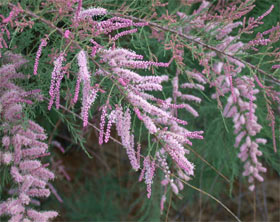 Tamarisk
was sold as an ornamental plant in the 1800s and 1900s. Mature
tamarisk trees can produce millions of tiny seeds that easily
disperse through wind and water, and these seeds quickly escaped
from gardens and started taking over the banks of streams and
rivers. Tamarisk grows rapidly and can reach heights of twenty
feet, and its taproot can extend more than one hundred feet
underground. Tamarisk
was sold as an ornamental plant in the 1800s and 1900s. Mature
tamarisk trees can produce millions of tiny seeds that easily
disperse through wind and water, and these seeds quickly escaped
from gardens and started taking over the banks of streams and
rivers. Tamarisk grows rapidly and can reach heights of twenty
feet, and its taproot can extend more than one hundred feet
underground.
Tamarisk is so invasive that it
has now spread to most of the western United States. The plant
provides poor habitat for native bird species, smothers native
willows and other plants, and consumes large amounts of water
from adjacent streams, leaving greatly-reduced water supplies
for fish and wildlife.
Tamarisk in the Sisquoc
River Watershed
Rivers in the Los Padres
National Forest have largely been spared from widespread
infestation, but there are some areas where tamarisk is becoming
established. If these smaller infestations are not removed, they
will release millions of seeds and become established in new
areas. By removing tamarisk before it takes over the entire
watershed, we will have a much better chance of keeping the
Sisquoc River in its natural state.

The U.S. Forest Service has
been conducting tamarisk removal projects on the Sisquoc River
since 1992, and recently prepared a management plan for the
Sisquoc River that calls for the removal of tamarisk and other
invasive exotic species that present a threat to the ecosystem.
Early in 2008, ForestWatch and
local forest officials discussed launching a tamarisk removal
project throughout the Sisquoc River watershed, focusing first
on areas of known infestations and then working our way up the
watershed.
Our April 2008 Tamarisk
Eradication Project
Early on Thursday morning,
April 17, a team of six ForestWatch volunteers converged near
Nira Campground at the end of Sunset Valley Road in the Los
Padres National Forest. Joining us were three officials from the
U.S. Forest Service, and two hydrologists who
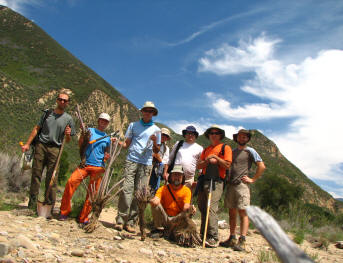 came
to revisit the site of the 2006 dam removal project on Horse
Creek, a tributary to the Sisquoc River. After a nice hike down
Manzana Creek, we arrived at Schoolhouse Camp in early afternoon
and established what would become our base camp for the next
three days. This site, nestled amongst the oaks and sycamores
near the confluence of Manzana Creek and the Sisquoc River, was
a picturesque and central location for our work over the next
few days. came
to revisit the site of the 2006 dam removal project on Horse
Creek, a tributary to the Sisquoc River. After a nice hike down
Manzana Creek, we arrived at Schoolhouse Camp in early afternoon
and established what would become our base camp for the next
three days. This site, nestled amongst the oaks and sycamores
near the confluence of Manzana Creek and the Sisquoc River, was
a picturesque and central location for our work over the next
few days.
Our goal on this trip was to
inventory and eradicate all tamarisk plants from the Forest
boundary upstream to Mormon Camp, a distance of about ten miles.
(Little did we know that we'd find so much tamarisk that we
wouldn't even cover half that distance!) After a hearty pasta
dinner, we all retired to our tents to rest up for the full day
of work ahead of us.
Days Two & Three: Dozens of
Tamarisk Eradicated!
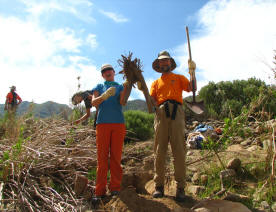 Our
first full work day began with an instruction from the Los
Padres National Forest biologist, who instructed all volunteers
on how to avoid sensitive habitat areas along the creek. Because
the Sisquoc River harbors critical populations of endangered
species, it was important that we avoid stirring up sediment in
breeding areas. After our training, it only took a few steps
before we stumbled upon our first tamarisk plants. They were, in
a word, eradicated. Then we moved upstream, spending a
full day covering more than two miles of the riverbed before
returning to base camp for another feast. Our
first full work day began with an instruction from the Los
Padres National Forest biologist, who instructed all volunteers
on how to avoid sensitive habitat areas along the creek. Because
the Sisquoc River harbors critical populations of endangered
species, it was important that we avoid stirring up sediment in
breeding areas. After our training, it only took a few steps
before we stumbled upon our first tamarisk plants. They were, in
a word, eradicated. Then we moved upstream, spending a
full day covering more than two miles of the riverbed before
returning to base camp for another feast.
 On
Day 3, we awoke to an overcast morning, perfect weather for
tamarisk hunting. We returned to our end point from the previous
day, continuing upstream another two miles and finding plenty of
mature tamarisk plants along the way. Many of the tamarisk we
found were nearly ten feet tall and in full bloom, and we
delivered their ultimate demise, just days before they would
have sent millions of tiny seeds around the watershed. Our
volunteers on foot were assisted by another team of volunteers
on horseback, who tackled a large infestation of tamarisk
several miles further upstream. On
Day 3, we awoke to an overcast morning, perfect weather for
tamarisk hunting. We returned to our end point from the previous
day, continuing upstream another two miles and finding plenty of
mature tamarisk plants along the way. Many of the tamarisk we
found were nearly ten feet tall and in full bloom, and we
delivered their ultimate demise, just days before they would
have sent millions of tiny seeds around the watershed. Our
volunteers on foot were assisted by another team of volunteers
on horseback, who tackled a large infestation of tamarisk
several miles further upstream.
Day Four: Wildflowers and
Views Along Hurricane Deck
Day 4 greeted us with a layer of frost on our gear and early morning
temperatures in the upper 20s. After warming up around the
campfire, we dismantled base camp, gathered up our
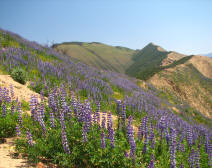 gear,
and ascended up the ridge of Hurricane Deck on our way home.
"The Deck" was a palate of wildflowers, with last year's Zaca
Fire bringing vivid displays of entire hillsides covered in fire
poppies, lupines, and dozens of other wildflowers. We stopped by
a Native American rock art site before descending towards
Manzana Creek and ultimately returning to our cars. gear,
and ascended up the ridge of Hurricane Deck on our way home.
"The Deck" was a palate of wildflowers, with last year's Zaca
Fire bringing vivid displays of entire hillsides covered in fire
poppies, lupines, and dozens of other wildflowers. We stopped by
a Native American rock art site before descending towards
Manzana Creek and ultimately returning to our cars.
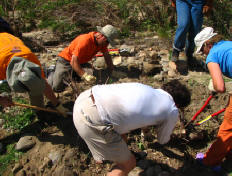 By
the end of the trip, we had removed more than fifty mature
tamarisk plants from a four-mile stretch of the Sisquoc River.
We didn't get as far as we had expected, as most of the tamarisk
we found were mature plants and could not be pulled out by hand.
Nor could they just be trimmed - they will resprout from the
roots. Instead, our volunteers went to the root of the problem -
the roots. We carefully dug around most of the plants, cutting
the root deep beneath the surface and handing the evil-doing plants their ultimate demise! By
the end of the trip, we had removed more than fifty mature
tamarisk plants from a four-mile stretch of the Sisquoc River.
We didn't get as far as we had expected, as most of the tamarisk
we found were mature plants and could not be pulled out by hand.
Nor could they just be trimmed - they will resprout from the
roots. Instead, our volunteers went to the root of the problem -
the roots. We carefully dug around most of the plants, cutting
the root deep beneath the surface and handing the evil-doing plants their ultimate demise!
As our dedicated team of
ForestWatch volunteers, our U.S. Forest Service crew, and our
horse and mule support team, we left the Sisquoc River with a
sense of accomplishment, knowing that wildness has been restored
to a four mile stretch of this pristine watershed.
More Work Projects Planned
for 2008
With four miles of the Sisquoc
River restored, we still have more than twenty miles to go!
 ForestWatch is organizing additional tamarisk
work projects in the Sisquoc River in Fall and Winter 2008,
after the summer heat passes.
By the end of the year, we hope to have eradicated tamarisk from
twelve miles of stream (one-third of the entire river inside the
Los Padres). If you have a hearty appetite for adventure, we
hope you'll join us on our next trek into the mighty Sisquoc! ForestWatch is organizing additional tamarisk
work projects in the Sisquoc River in Fall and Winter 2008,
after the summer heat passes.
By the end of the year, we hope to have eradicated tamarisk from
twelve miles of stream (one-third of the entire river inside the
Los Padres). If you have a hearty appetite for adventure, we
hope you'll join us on our next trek into the mighty Sisquoc!
|

